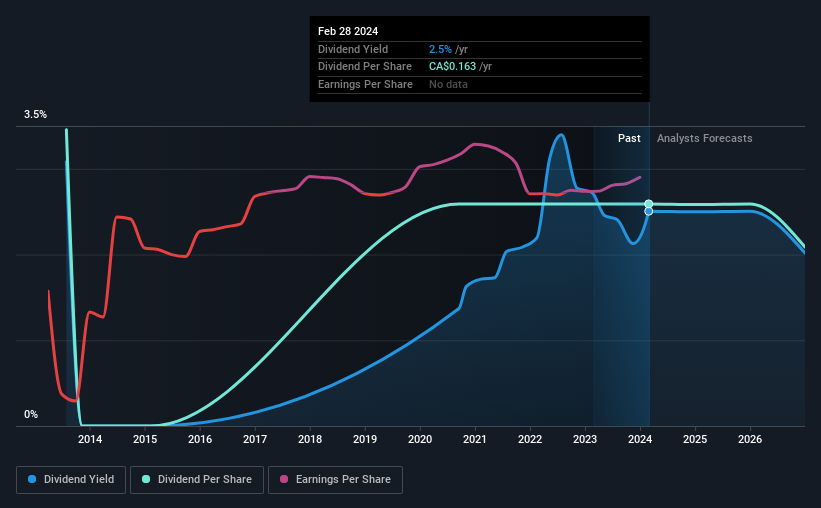Kinross Gold Corporation (TSE:K) Pays A US$0.03 Dividend In Just Four Days
Kinross Gold Corporation (TSE:K) stock is about to trade ex-dividend in four days. The ex-dividend date is one business day before a company's record date, which is the date on which the company determines which shareholders are entitled to receive a dividend. The ex-dividend date is an important date to be aware of as any purchase of the stock made on or after this date might mean a late settlement that doesn't show on the record date. This means that investors who purchase Kinross Gold's shares on or after the 5th of March will not receive the dividend, which will be paid on the 21st of March.
The company's next dividend payment will be US$0.03 per share, on the back of last year when the company paid a total of US$0.12 to shareholders. Looking at the last 12 months of distributions, Kinross Gold has a trailing yield of approximately 2.5% on its current stock price of CA$6.50. Dividends are an important source of income to many shareholders, but the health of the business is crucial to maintaining those dividends. As a result, readers should always check whether Kinross Gold has been able to grow its dividends, or if the dividend might be cut.
Check out our latest analysis for Kinross Gold
Dividends are typically paid out of company income, so if a company pays out more than it earned, its dividend is usually at a higher risk of being cut. Kinross Gold paid out a comfortable 35% of its profit last year. That said, even highly profitable companies sometimes might not generate enough cash to pay the dividend, which is why we should always check if the dividend is covered by cash flow. Fortunately, it paid out only 37% of its free cash flow in the past year.
It's positive to see that Kinross Gold's dividend is covered by both profits and cash flow, since this is generally a sign that the dividend is sustainable, and a lower payout ratio usually suggests a greater margin of safety before the dividend gets cut.
Click here to see the company's payout ratio, plus analyst estimates of its future dividends.
Have Earnings And Dividends Been Growing?
Businesses with shrinking earnings are tricky from a dividend perspective. If earnings decline and the company is forced to cut its dividend, investors could watch the value of their investment go up in smoke. Kinross Gold's earnings per share have fallen at approximately 12% a year over the previous five years. Ultimately, when earnings per share decline, the size of the pie from which dividends can be paid, shrinks.
Another key way to measure a company's dividend prospects is by measuring its historical rate of dividend growth. Kinross Gold has seen its dividend decline 2.8% per annum on average over the past 10 years, which is not great to see. While it's not great that earnings and dividends per share have fallen in recent years, we're encouraged by the fact that management has trimmed the dividend rather than risk over-committing the company in a risky attempt to maintain yields to shareholders.
Final Takeaway
Is Kinross Gold an attractive dividend stock, or better left on the shelf? Kinross Gold has comfortably low cash and profit payout ratios, which may mean the dividend is sustainable even in the face of a sharp decline in earnings per share. Still, we consider declining earnings to be a warning sign. In summary, it's hard to get excited about Kinross Gold from a dividend perspective.
In light of that, while Kinross Gold has an appealing dividend, it's worth knowing the risks involved with this stock. For example, we've found 1 warning sign for Kinross Gold that we recommend you consider before investing in the business.
Generally, we wouldn't recommend just buying the first dividend stock you see. Here's a curated list of interesting stocks that are strong dividend payers.
Have feedback on this article? Concerned about the content? Get in touch with us directly. Alternatively, email editorial-team (at) simplywallst.com.
This article by Simply Wall St is general in nature. We provide commentary based on historical data and analyst forecasts only using an unbiased methodology and our articles are not intended to be financial advice. It does not constitute a recommendation to buy or sell any stock, and does not take account of your objectives, or your financial situation. We aim to bring you long-term focused analysis driven by fundamental data. Note that our analysis may not factor in the latest price-sensitive company announcements or qualitative material. Simply Wall St has no position in any stocks mentioned.

